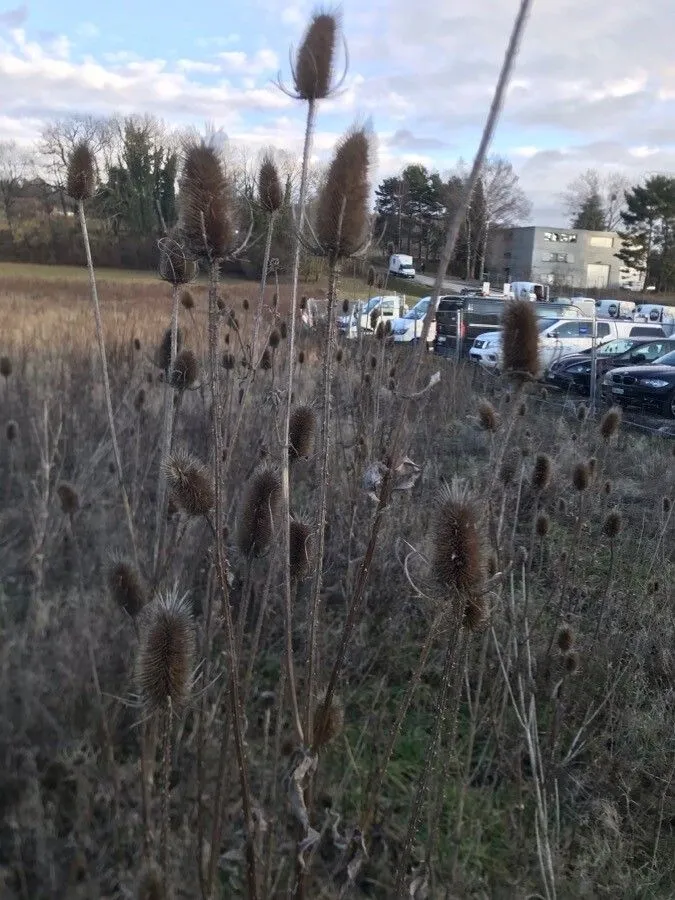
Author: (L.) Honck.
Bibliography: Verz. Gew. Teutschl. 1: 374 (1782)
Year: 1782
Status: accepted
Rank: species
Genus: Dipsacus
Vegetable: False
Observations: a cultigen from Europe to Caucasus
The Indian teasel, known scientifically as Dipsacus sativus, is a captivating plant that has garnered attention for its unique characteristics and historical significance. This fascinating species belongs to the Caprifoliaceae family, a botanical group known for its diverse and often ornamental members.
Indian teasel is a cultigen, meaning it has been cultivated by humans over time. Its historical cultivation can be traced back to regions spanning Europe to the Caucasus, where it has been valued for various uses. The plant was first cataloged in 1782 by the German botanist Honck in his work “Verz. Gew. Teutschl.,” underlining its long-standing presence in botanical studies and horticulture.
The morphological features of Dipsacus sativus make it particularly notable. It typically presents with tall, sturdy stems covered in prickly bracts. These stems support striking, cone-shaped inflorescences that are not only visually intriguing but also serve practical uses. Historically, the dried flower heads of the Indian teasel were utilized in the textile industry for raising the nap on fabrics, a testament to their utility beyond mere aesthetics.
The plant thrives in a variety of soils but prefers well-drained conditions and a sunny environment. These requirements have allowed Indian teasel to be successfully cultivated in a range of locales outside its native range, adapting well to cultivated garden settings.
In addition to its practical applications, Indian teasel has also found a place in traditional medicine. Some cultures have utilized parts of the plant for their purported medicinal properties, although contemporary scientific validation of these uses is limited.
In summary, the Indian teasel is a plant of considerable historical and botanical interest. Its distinctive appearance and practical applications have ensured its cultivation and study across various regions from Europe to the Caucasus. This resilient and versatile plant continues to be a subject of admiration and utility, bridging the gap between the ornamental and the practical in the plant world.
Fra: cardère cultivée, cardère à foulon, cardaire à foulons
Eng: fuller’s teasel, indian teasel, wild teasel, card’s thistle
Deu: weber-karde
Por: cardo-cardador, cardo-penteador
Spa: cardo-de-cardador
Hun: takácsmácsonya
Swe: vävarkarda
Dan: ægte kartebolle
Ces: štetka siata, štětka soukenická
Nld: weverskaarde
Nob: hagekardeborre
Nno: hagekardeborre
Cym: crib bachog, cribau’r pannwr
En: Indian teasel, Fuller’s teasel, Card’s thistle, Wild Teasel, Fuller’s Teazle
Ca: Carda de paraire, Cardó de paraire, Cardot de paraire
Cs: Štetka siata, Štětka soukenická
Da: Ægte kartebolle
Nl: Weverskaarde
Fi: Pikarikarstaohdake
Fr: Cardaire à foulons, Cardère cultivée, Cardère à foulon, Chardon à foulon, Cardère
De: Weber-Karde, Card’s Thistle
Hu: Takácsmácsonya
It: Cardo dei lanajuoli
Nb: Hagekardeborre
Nn: Hagekardeborre
Pt: Cardo-cardador, Cardo-penteador
Es: Cardo-de-cardador
Sv: Vävarkarda
Cy: Crib Bachog, Cribau’r Pannwr
Taken Sep 6, 2019 by Wilfried Paszkowski (cc-by-sa)
Taken Jan 3, 2022 by David Hocken (cc-by-sa)
Taken Jan 3, 2022 by David Hocken (cc-by-sa)
Taken Dec 19, 2021 by Damien Vieillevigne (cc-by-sa)
Taken Jan 3, 2022 by David Hocken (cc-by-sa)
Taken Dec 5, 2021 by Eddy Oldy (cc-by-sa)
Taken Jan 30, 2022 by Kerrie Knight (cc-by-sa)
Taken Sep 19, 2020 by Volkov Dmitry (cc-by-sa)
Taken Apr 19, 2020 by Matthias Weiss (cc-by-sa)
Taken Feb 4, 2022 by geneve perma (cc-by-sa)
Taken Jan 27, 2022 by Monteiro Henrique (cc-by-sa)
Taken May 25, 2022 by Quentin Watier (cc-by-sa)
Taken Jul 27, 2021 by Margarita Sonya Marie Quihuiz Castro (cc-by-sa)
Taken Jan 13, 2022 by Monteiro Henrique (cc-by-sa)
Taken Jan 17, 2022 by Monteiro Henrique (cc-by-sa)
Taken Mar 18, 2022 by Bambini Maurizio (cc-by-sa)
Taken Apr 27, 2022 by dubmigella scapigliata (cc-by-sa)
Taken Sep 9, 2022 by geneve perma (cc-by-sa)
Taken Jan 17, 2022 by Monteiro Henrique (cc-by-sa)
Taken Feb 4, 2022 by geneve perma (cc-by-sa)
Taken Mar 10, 2022 by Aurelien Fridman (cc-by-sa)
Taken Jun 4, 2022 by An Wü (cc-by-sa)
Taken Oct 4, 2021 by Aimee Cook (cc-by-sa)
Taken Sep 22, 2019 by parramon marta (cc-by-sa)
Taken Nov 9, 2022 by Gabriele Ariagno (cc-by-sa)
Taken Jul 15, 2009 by Photoflora – Benoit BOCK (©)
Taken Jul 15, 2013 by Photoflora – Benoit BOCK (©)
Taken Jan 1, 1970 by Photoflora – L’Abbé COSTE (©)
Taken Sep 23, 2022 by Georgia C (cc-by-sa)
Taken Jan 13, 2022 by Monteiro Henrique (cc-by-sa)
© copyright of the Board of Trustees of the Royal Botanic Gardens, Kew.
© copyright of the Board of Trustees of the Royal Botanic Gardens, Kew.
© copyright of the Board of Trustees of the Royal Botanic Gardens, Kew.
Growth habit>: Forb/herb
Ph maximum: 7.0
Ph minimum: 6.5
Light: 7
Atmospheric humidity: 4
Soil nutriments: 6
Family: Myrtaceae Author: (F.Muell.) K.D.Hill & L.A.S.Johnson Bibliography: Telopea 6: 402 (1995) Year: 1995 Status:…
Family: Rubiaceae Author: Pierre ex A.Froehner Bibliography: Notizbl. Bot. Gart. Berlin-Dahlem 1: 237 (1897) Year:…
Family: Sapindaceae Author: Koidz. Bibliography: J. Coll. Sci. Imp. Univ. Tokyo 32(1): 38 (1911) Year:…
Family: Asteraceae Author: A.Gray Bibliography: Pacif. Railr. Rep.: 107 (1857) Year: 1857 Status: accepted Rank:…
Family: Fabaceae Author: Medik. Bibliography: Vorles. Churpfälz. Phys.-Ökon. Ges. 2: 398 (1787) Year: 1787 Status:…
Family: Aspleniaceae Author: (Cav.) Alston Bibliography: Bull. Misc. Inform. Kew 1932: 309 (1932) Year: 1932…